What is the difference between timber framing and post and beam? Many people have a hard time distinguishing between the two methods of building with heavy timbers. Primarily the difference is with the connections.
Both timber frame and post and beam construction utilize durable heavy timbers, as opposed to dimensional lumber that can be purchased from any lumber yard. Dimensional lumber has been cut to pre-defined, standard sizes such as 2x4’s, etc. The heavy timbers used in both post and beam and timber frame are much larger and generally remain exposed in the building, creating an honest expression of the structure and giving it a sturdy appearance. When it is designed and constructed with care and skill, the beauty of the frame itself creates the artistic character of the building. The organic beauty of wood is celebrated in the exposed timberwork whether post and beam or timber frame.
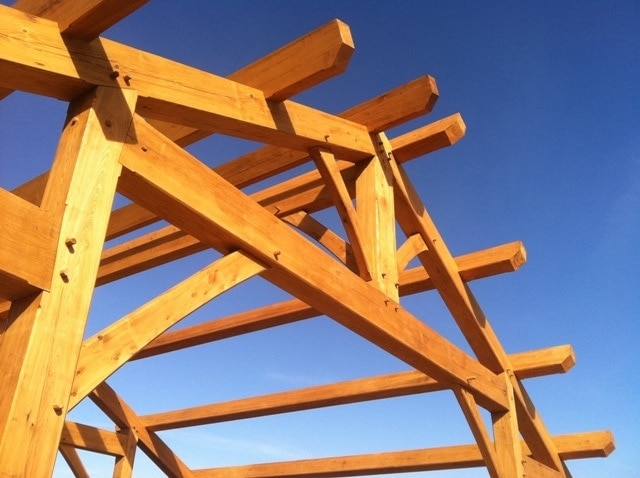
Similarities of Post and Beam and Timber Frame
Both timber framing and post and beam are construction methods in which the structural frame is self-supporting and carries the weight of the house. This means that interior load-bearing walls are unnecessary for both methods, making large open interior spaces and high vaulted ceilings possible. When the frame is left exposed (as usual), an organic beauty enhances the building. Both types of frames are usually prefabricated in a sheltered environment usually with green timbers, then labeled and delivered to the job site, where you or a contractor can raise them.
Both timber framing and post-and-beam are shining examples of sustainable construction. Often, the wood in these frames is reused from existing structures or harvested from standing dead forests, minimizing the demand for new timber. Moreover, the way these timbers are assembled allows for easy disassembly and repurposing in future buildings, further reducing waste and environmental impact. This emphasis on sustainability should reassure the audience about the responsible nature of these construction methods.
Differences between Post and Beam and Timber Frame
The main difference between these two systems is how the timbers are joined. Timber framing dates back to medieval times, and structures built then still stand today. This method has evolved over centuries, with new techniques and tools being developed to improve its efficiency and durability. Timber frames utilize traditional joinery such as mortise and tenons. They incorporate very few metal parts - mainly hidden structural screws where absolutely necessary, such as securing rafters to a ridge. In post and beam buildings, the timbers are usually connected with metal fasteners and connectors, which can be hidden or decorative. This method, while more modern, still relies on the strength and durability of heavy timbers.
Post and beam usually use half-lap joinery. The fasteners securing the timbers may be hidden within connections or exposed and decorative. Timber Frame uses mortise and tenons, scarf joints, spline joints, and other joinery secured with wooden pegs. The cost of skilled labor to cut and fit the joints is much higher in a timber frame home than in a post and beam. However, the metal connectors in a post and beam building can be a significant cost factor.
The raising (erecting) process differs for a timber frame from a post and beam building. The timber frame sections are assembled on the ground and then erected individually until the entire framework is completed. With post & beam construction, the frame is built from the ground up, with the parts being added on top of each other.
Timber Framing Characteristics
Post and Beam Characteristics
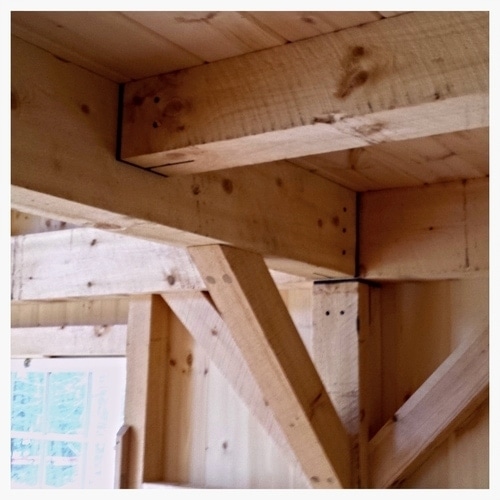
Post and Beam Framing
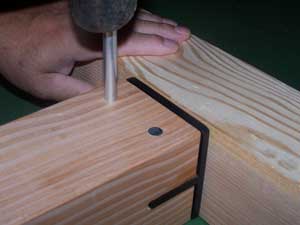
Post and Beam Connection with T-Rex
Advantages of Timber Frame
Disadvantages of Timber Frame
Advantages of Post and Beam
Disadvantages of Post and Beam
Timber Connections
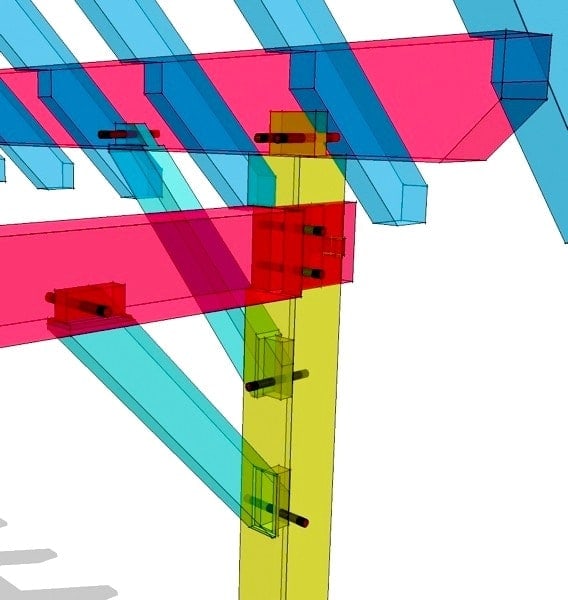
Timber Connections
Timber framing is a construction method used for centuries by our forefathers, and they brought to the United States the skills they developed in Europe and elsewhere (Japan, for instance). These craftsmen use traditional methods of wood joinery to piece together large, usually squared timbers. The connections are carved, usually by hand, to join every piece of wood by interlocking. An example of such a connection is a mortise and tenon joint. When the connection is made, it is usually with wooden pegs because the use of metal is not usually practiced with timber framing. The pegs are visible at the joints, and seeing them is a good indication that a structure is timber-framed. Cutting and fitting the traditional joinery is time-consuming and requires a high skill level. There are schools that offer courses to teach these methods such as the ones found here.
Post and Beam, in contrast to timber framing, does not involve mortise and tenon joinery. This method of framing also uses heavy timbers, however, the connections are much less complicated; fasteners in the form of metal screws, bolts and plates are used to connect the timber pieces. Sometimes the connections are reinforced and decorated with metal plates. Other times the connectors are hidden so the structures look very similar to timber framed structures, except without visible pegs. These simpler connections usually require less time to craft. A business like Simpson Strong Tie offers plates and bracing that provide a functional solution in their Architectural Connector product line.
A Post and Beam Connector System by Rothoblaas
One company to offer an alternative to both framing with mortise and tenon, and framing with angle/corner bracing or steel plates is Rothoblaas, with their connector system.Most of the Rothoblaas connectors are of the hidden variety.
Rothoblaas has some extruded aluminum connectors that require no special skills to install, as well as well as a wide range of other connectors for your project. Due to their experience internationally, Rothoblaas has created simple connections that balance the art of timber framing with the modern developments of post and beam. With Rothoblaas, it is not necessary to spend the time and learn the skills needed for traditional methods. And the large metal plates and corner bracing common in post and beam construction are not necessary with these connectors. Framing with Rothoblaas post and beam connectors presents a viable alternative with a minimal metal look that is engineer-approved and cost effective. Plans utilizing these connectors are available at from us here and you can find the connectors in our online shop.
Timber framing and post and beam construction both demand tight, well-crafted joints, but post and beam fabrication is usually less labor-intensive. It is often very hard to distinguish between a timber frame and a well-crafted post and beam structure. The appreciation for traditional craftsmanship versus cost are determining factors in deciding which approach to use. Timber framing can add 25% over the cost of a stick-built home. Timber framing can cost 10-15% more than post and beam construction. Post and beam construction and timber framing both celebrate the beauty of wood, but post and beam breaks from pure traditional joinery.
In conclusion, building with larger timbers encourages personal design choices, showcasing either a handmade and rustic look, or a sleek and more modern appearance.
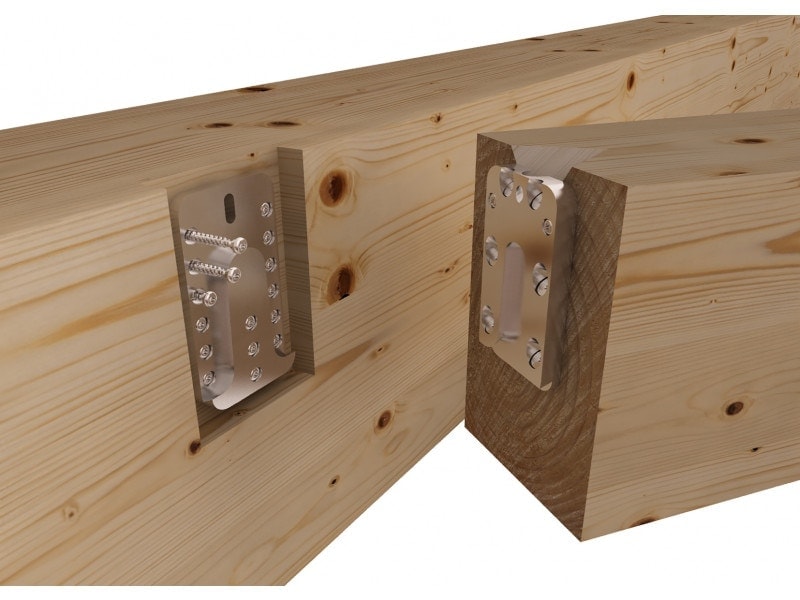
Hey Brice,
Paul Freeman from Brooks Post & Beam here. We could very well be the oldest timber framing company in the country. Our founder built his first timber frame in 1968 and gradually grew the business from timber frame restoration to cutting of new frames, incorporating in the ’80’s as a sub-s corporation.
We occasionally employ steel in our frames to meet modern codes or simply to save a client significant labor expense on joinery that would mostly be invisible and under-appreciated by laymen. However 99% of our joints are mortise and tenon, pocketed timbers, or mortise and spline joinery.
We are timber framers, I am a past president of the Timber Framer’s Business Council and board member of the Timber Framer’s Guild. My company name is Brooks “Post & Beam”. When we started, “timber-framing” was not a classification for construction, “Post & Beam” was a broader description and over the years timber framing has grown to describe the craft of building timber frames in a traditional manner. Personally I define timber framing as a subset of post & beam. In other words timber frames are post & beam structures but not all post & beam structures are timber frames.
It should be mentioned that in the larger commercial environment heavy timber construction is used as a general description of any construction using timbers, glulams, and other large manufactured structural wood products.
I recognize that many timber framers describe post & beam as you have here. However, if you were to poll the general population I think you’ll find that post and beam is the common description of heavy timber framed structures. It is a phrase easily recognized and one could argue is a de facto definition.
I have been following the development of your website over the last few years and you have done a great job. Ed Levin and I developed TimberCAD many years ago and invested untold hours in that venture not for fame or fortune but simply out of a passion to develop a tool used in the development of timber framing. I see your effort as a similar outlet of passion for the trade and a tool to expand the timber frame industry. Good Work and Thank You!
Thanks for your comments and thoughts Paul.
I agree with you about the a general polling of folks and their interpretation of timber framing and post and beam structures. I have also found people who consider a timber frame a log home, as you know education is the key.
For me I am happy if folks use timbers instead of LVL and glulams to solve their structural needs. I actually used TimberCAD for a little while back in the beginning of my design career. Thanks for all you do for the industry.
Thanks for the clarification. I am planning on building a Timber Frame on my property in Williams Az. I am a Blacksmith and not only am I going to build the home but I have started making the Slicks and chisels to do it. I was always confused by the difference between “Post and Beam” and “Timber Framing” I have been thinking about all the joinery and am a bit intimidated by the whole process. I am working on the drawings for the Building permit and was considering using steel in a number of places throughout the structure. Some for the decorative aspect but also structurally as well. I bought and downloaded your 20′ x 20′ shed drawings. They are a great asset for me as I do the drawings for the house. I’ll build the shed and probably modify it some this spring and it will be used as the wood shop initially then the Blacksmth shop later on. The process should help me determine if I am out of my mind to think I could build the house as a Timber Frame. I don’t see the need to do all the joinery if it is going to be buried when the simplest solution is to use steel plates and thru-bolts. The joinery that will be exposed is what i really want to excentuate. It is very similar to the work that I do in iron. You have to have dreams. Thanks for all the information . Great website. Tim Cisneros http://www.theforgeworks.com
Thanks Tim,
Checked out your website and your work. Good luck with your progress, keep us posted.